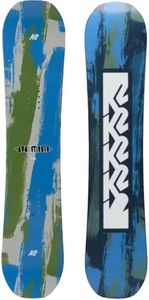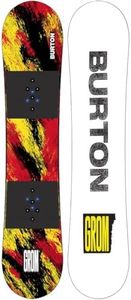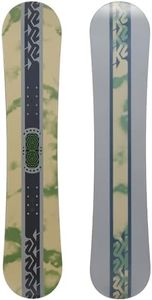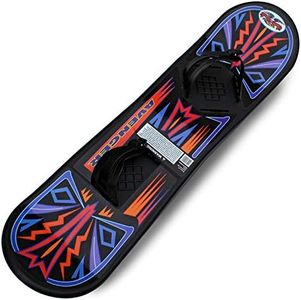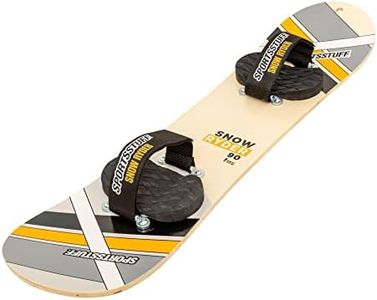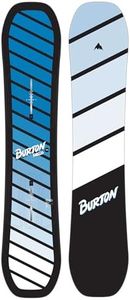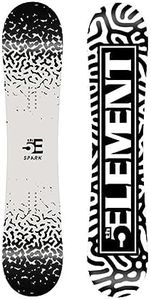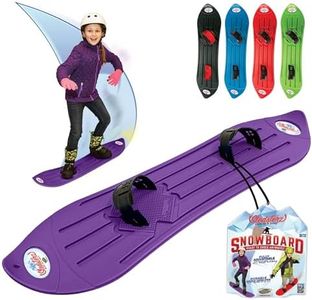10 Best Snowboard For Kids Beginner 2025 in the United States
Our technology thoroughly searches through the online shopping world, reviewing hundreds of sites. We then process and analyze this information, updating in real-time to bring you the latest top-rated products. This way, you always get the best and most current options available.

Our Top Picks
Winner
Burton Kids' Mini Grom Rocker Snowboard, 90cm
The Burton Kids' Mini Grom Rocker Snowboard, sized at 90cm, is designed specifically for beginner kids. The length of 90cm makes it suitable for young children, ensuring it's easy to handle. The snowboard features a Twin Shape, which is symmetrical from tip to tail, providing balance for kids whether they ride regular or switch. This is particularly helpful for beginners still figuring out their riding stance. Additionally, the Twin Flex further ensures even flexibility, making the ride smooth and predictable.
The Flat Top Bend offers stability, balance, and edge control, which is crucial for kids just starting out and needing a forgiving ride. The Easy Bevel feature lifts the board's edges off the snow, reducing the chances of catching an edge and falling, which boosts confidence and safety for young riders. Constructed with a Fly Core, this snowboard is lightweight (3 pounds), ensuring kids find it easy to maneuver without sacrificing performance. The use of Biax Fiberglass adds to its soft flex, making it more forgiving and easier to control. The Extruded Base is low maintenance and durable, providing both speed and strength.
A one-year warranty from Burton offers peace of mind regarding the snowboard's durability. However, the board's relatively small size and soft flex might limit its use as children grow and advance their skills. Additionally, the limited color options (only one available) might not appeal to every child. Despite these minor drawbacks, the snowboard's design and features make it a great choice for young beginners learning to snowboard.
Burton Kids' Riglet Snowboard, 90cm
The Burton Kids' Riglet Snowboard, sized at 90cm, is designed specifically for beginner children, making it a perfect entry-level option for young snowboarders. One of its main strengths is the Twin Shape, which ensures a symmetrical and balanced ride whether going straight or switch, giving kids a consistent experience. The Twin Flex further supports this symmetry from tip to tail, promoting an easy and forgiving ride.
The Flat Top Bend offers stability and balance, making edge control easier for beginners, reducing the likelihood of falls. Additionally, the Easy Bevel feature lifts the edges off the snow to prevent catching edges, which is particularly beneficial for young learners still mastering their balance and movements. At 3 pounds, the board is lightweight, making it manageable for kids to carry and maneuver on their own.
The dimensions of 36 inches in length and 10 inches in width provide a stable base without being too cumbersome. The board is backed by a one-year warranty, which adds a layer of confidence in its durability. However, the board's size and weight limit of 50 pounds mean it's best suited for younger or smaller children, and may not accommodate those who are older or heavier. Some users might find the simplicity of the flat top shape limiting as their child progresses to more advanced snowboarding techniques. In summary, the Burton Kids' Riglet Snowboard is an excellent starting point for young kids new to snowboarding, offering stability, safety, and ease of use, but it might need to be replaced as the child grows and advances in skill.
SportsStuff Snow Ryder PRO Hardwood Snowboard, 130cm, Beginner's Wood Snowboard
Most important from
194 reviews
The SportsStuff Snow Ryder PRO Hardwood Snowboard is a solid choice for kids just starting out with snowboarding, especially for backyard practice or gentle snow play. Its 130cm length is suitable for many young riders, and the durable hardwood construction means it can handle some wear and tear. The raised nose and tail design allow kids to ride in multiple directions, which is great for beginners learning control and balance. The ratchet-style bindings help keep feet secure without complicated adjustments.
This board lacks metal edges, so it’s not designed for use on ski resorts or hard-packed snow — it’s best for softer surfaces and casual riding. It has a medium width and flex appropriate for beginners, but it’s limited to riders under 150 pounds. Without a camber profile or advanced shape features, it won’t perform well on challenging slopes or for progressing into more serious snowboarding. For a simple, tough, and easy-to-use board for a child’s first snow experiences, this is a practical pick, ideal for gentle, low-risk environments rather than mountain resorts.



